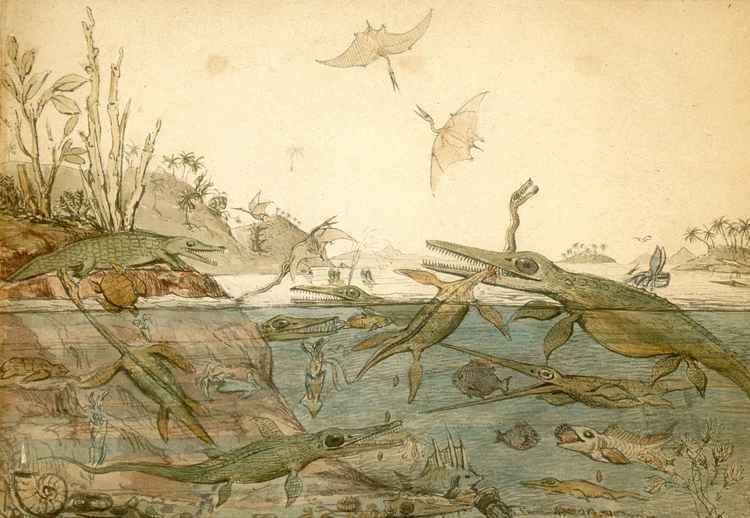 | ||
Paleoart (also spelled palaeoart, paleo-art, or paleo art) is any original artistic work that attempts to reconstruct or depict prehistoric life according to the current knowledge and scientific evidence at the moment of creating the artwork. The term paleoart was introduced in the late 1980s by Mark Hallett for art that depicts subjects related to paleontology. These may be representations of fossil remains or depictions of the living creatures and their ecosystems. The term is a portmanteau of “art” and the ancient Greek word for old.
Contents
Production
The work of paleoartists is not mere fantasy of an artist's imagination but rather consists of cooperative discussions among experts and artists. When attempting to reconstruct an extinct animal, the artist must utilise an almost equal mixture of artistry and scientific knowledge. The artist James Gurney, known for the Dinotopia series of fiction books, has described the interaction between scientists and artists as the artist being the eyes of the scientist, since his illustrations bring shape to the theories; palaeoart determines how the public perceives long extinct animals.
Scientific impact
Extinct marine animals were some of the first to be restored as in life. Art has been important in disseminating knowledge of dinosaurs since the term was introduced by Sir Richard Owen in 1842. With Benjamin Waterhouse Hawkins, Owen helped create the first life-size sculptures depicting dinosaurs as he thought they may have appeared. Some models were initially created for the Great Exhibition of 1851, but 33 were eventually produced when the Crystal Palace was relocated to Sydenham, in South London. Owen famously hosted a dinner for 21 prominent men of science inside the hollow concrete Iguanodon on New Year's Eve 1853. However, in 1849, a few years before his death in 1852, Gideon Mantell had realised that Iguanodon, of which he was the discoverer, was not a heavy, pachyderm-like animal, as Owen was putting forward, but had slender forelimbs; his death left him unable to participate in the creation of the Crystal Palace dinosaur sculptures, and so Owen's vision of dinosaurs became that seen by the public. He had nearly two dozen lifesize sculptures of various prehistoric animals built out of concrete sculpted over a steel and brick framework; two Iguanodon, one standing and one resting on its belly, were included. The dinosaurs remain in place in the park, but their depictions are now outdated in many respects.
A 2013 study found that older paleoart was still influential in popular culture long after new discoveries made them obsolete. This was explained as cultural inertia. In a 2014 paper, Mark P. Witton, Darren Naish, and John Conway outlined the historical significance of paleoart, and lamented its current state.
Recognition
Since 1999, the Society of Vertebrate Paleontology has awarded the John J. Lanzendorf PaleoArt Prize for achievement in the field. The society says that paleoart "is one of the most important vehicles for communicating discoveries and data among paleontologists, and is critical to promulgating vertebrate paleontology across disciplines and to lay audiences". The SVP is also the site of the occasional/annual "PaleoArt Poster Exhibit", a juried poster show at the opening reception of the annual SVP meetings.
The Museu da Lourinhã organizes the annual International Dinosaur Illustration Contest for promoting the art of dinosaur and other fossils.
